Examining Criminal Justice System in Superhero Comic Book Mythos
VerifiedAdded on 2023/04/11
|5
|999
|118
Essay
AI Summary
This essay examines the depiction of misconduct and justice in the comic book "Superhero Mythos" by Scott Vellum Cary D. Atkinson, focusing on Batman and Superman as representations of crime and justice. It explores the structural framework in which superheroes operate, the nature of the crimes they combat, and the role of vigilantes within the context of the criminal justice system. The analysis draws upon theories such as voluntary vocational policing, differential association, and social justice to understand the portrayal of crime and unlawful behavior in Gotham and Metropolis. The essay concludes that while the book presents the police as often overwhelmed, it ultimately reinforces the idea that vigilante justice, though extra-legal, can significantly impact society's view of crime and justice, reflecting a simplistic 'tooth for a tooth' approach often perpetuated by media portrayals.
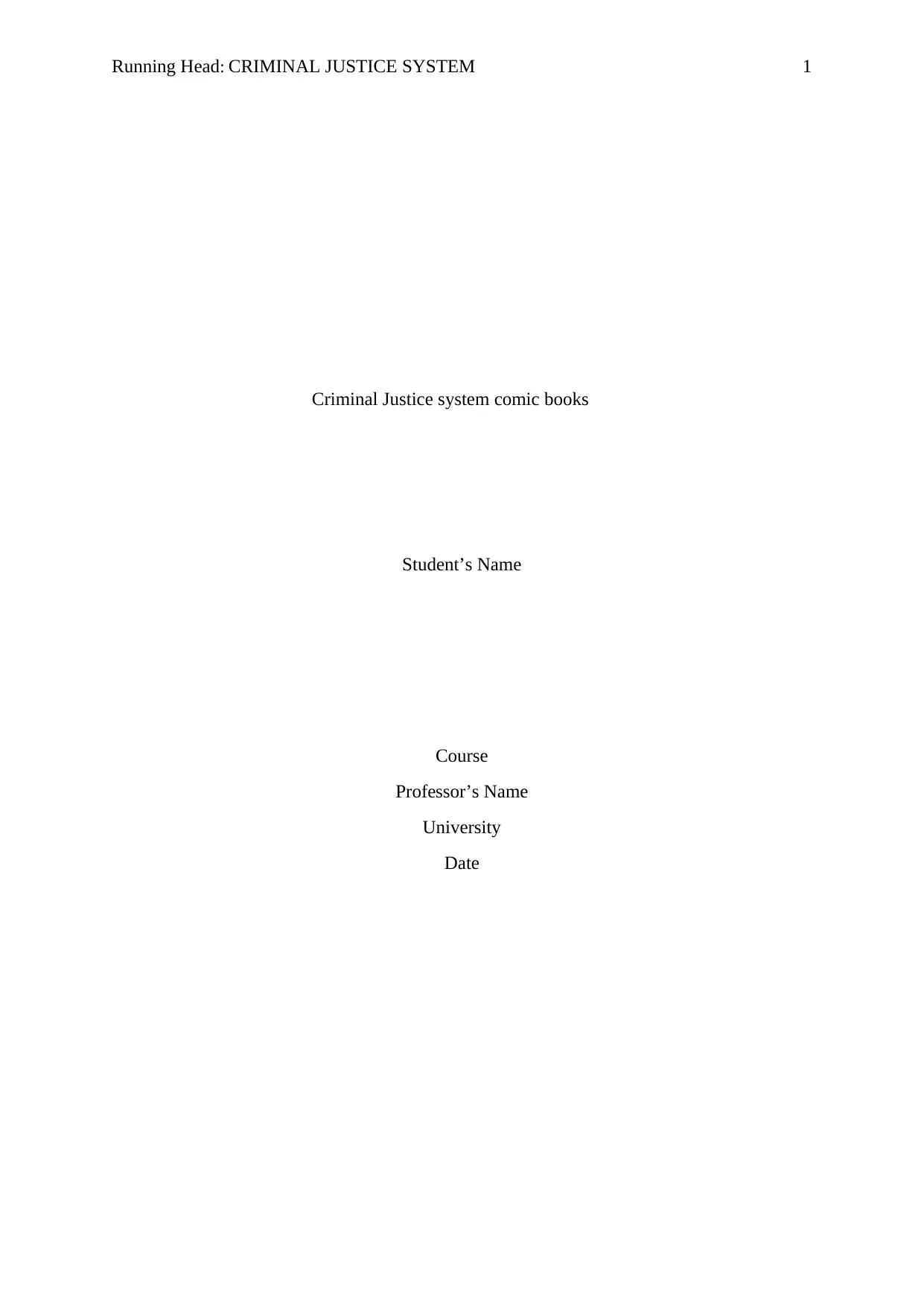
Running Head: CRIMINAL JUSTICE SYSTEM 1
Criminal Justice system comic books
Student’s Name
Course
Professor’s Name
University
Date
Criminal Justice system comic books
Student’s Name
Course
Professor’s Name
University
Date
Paraphrase This Document
Need a fresh take? Get an instant paraphrase of this document with our AI Paraphraser
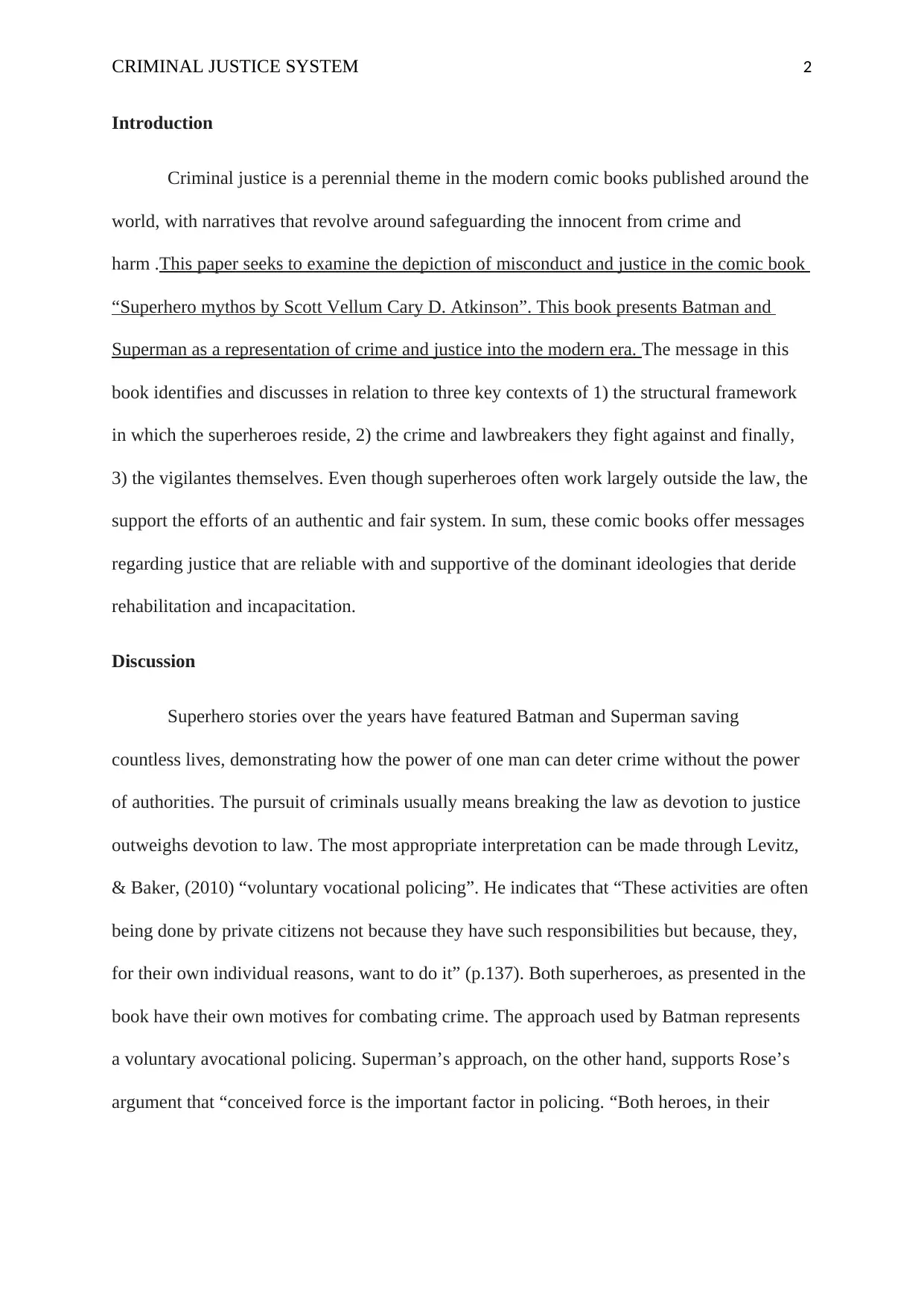
CRIMINAL JUSTICE SYSTEM 2
Introduction
Criminal justice is a perennial theme in the modern comic books published around the
world, with narratives that revolve around safeguarding the innocent from crime and
harm .This paper seeks to examine the depiction of misconduct and justice in the comic book
“Superhero mythos by Scott Vellum Cary D. Atkinson”. This book presents Batman and
Superman as a representation of crime and justice into the modern era. The message in this
book identifies and discusses in relation to three key contexts of 1) the structural framework
in which the superheroes reside, 2) the crime and lawbreakers they fight against and finally,
3) the vigilantes themselves. Even though superheroes often work largely outside the law, the
support the efforts of an authentic and fair system. In sum, these comic books offer messages
regarding justice that are reliable with and supportive of the dominant ideologies that deride
rehabilitation and incapacitation.
Discussion
Superhero stories over the years have featured Batman and Superman saving
countless lives, demonstrating how the power of one man can deter crime without the power
of authorities. The pursuit of criminals usually means breaking the law as devotion to justice
outweighs devotion to law. The most appropriate interpretation can be made through Levitz,
& Baker, (2010) “voluntary vocational policing”. He indicates that “These activities are often
being done by private citizens not because they have such responsibilities but because, they,
for their own individual reasons, want to do it” (p.137). Both superheroes, as presented in the
book have their own motives for combating crime. The approach used by Batman represents
a voluntary avocational policing. Superman’s approach, on the other hand, supports Rose’s
argument that “conceived force is the important factor in policing. “Both heroes, in their
Introduction
Criminal justice is a perennial theme in the modern comic books published around the
world, with narratives that revolve around safeguarding the innocent from crime and
harm .This paper seeks to examine the depiction of misconduct and justice in the comic book
“Superhero mythos by Scott Vellum Cary D. Atkinson”. This book presents Batman and
Superman as a representation of crime and justice into the modern era. The message in this
book identifies and discusses in relation to three key contexts of 1) the structural framework
in which the superheroes reside, 2) the crime and lawbreakers they fight against and finally,
3) the vigilantes themselves. Even though superheroes often work largely outside the law, the
support the efforts of an authentic and fair system. In sum, these comic books offer messages
regarding justice that are reliable with and supportive of the dominant ideologies that deride
rehabilitation and incapacitation.
Discussion
Superhero stories over the years have featured Batman and Superman saving
countless lives, demonstrating how the power of one man can deter crime without the power
of authorities. The pursuit of criminals usually means breaking the law as devotion to justice
outweighs devotion to law. The most appropriate interpretation can be made through Levitz,
& Baker, (2010) “voluntary vocational policing”. He indicates that “These activities are often
being done by private citizens not because they have such responsibilities but because, they,
for their own individual reasons, want to do it” (p.137). Both superheroes, as presented in the
book have their own motives for combating crime. The approach used by Batman represents
a voluntary avocational policing. Superman’s approach, on the other hand, supports Rose’s
argument that “conceived force is the important factor in policing. “Both heroes, in their
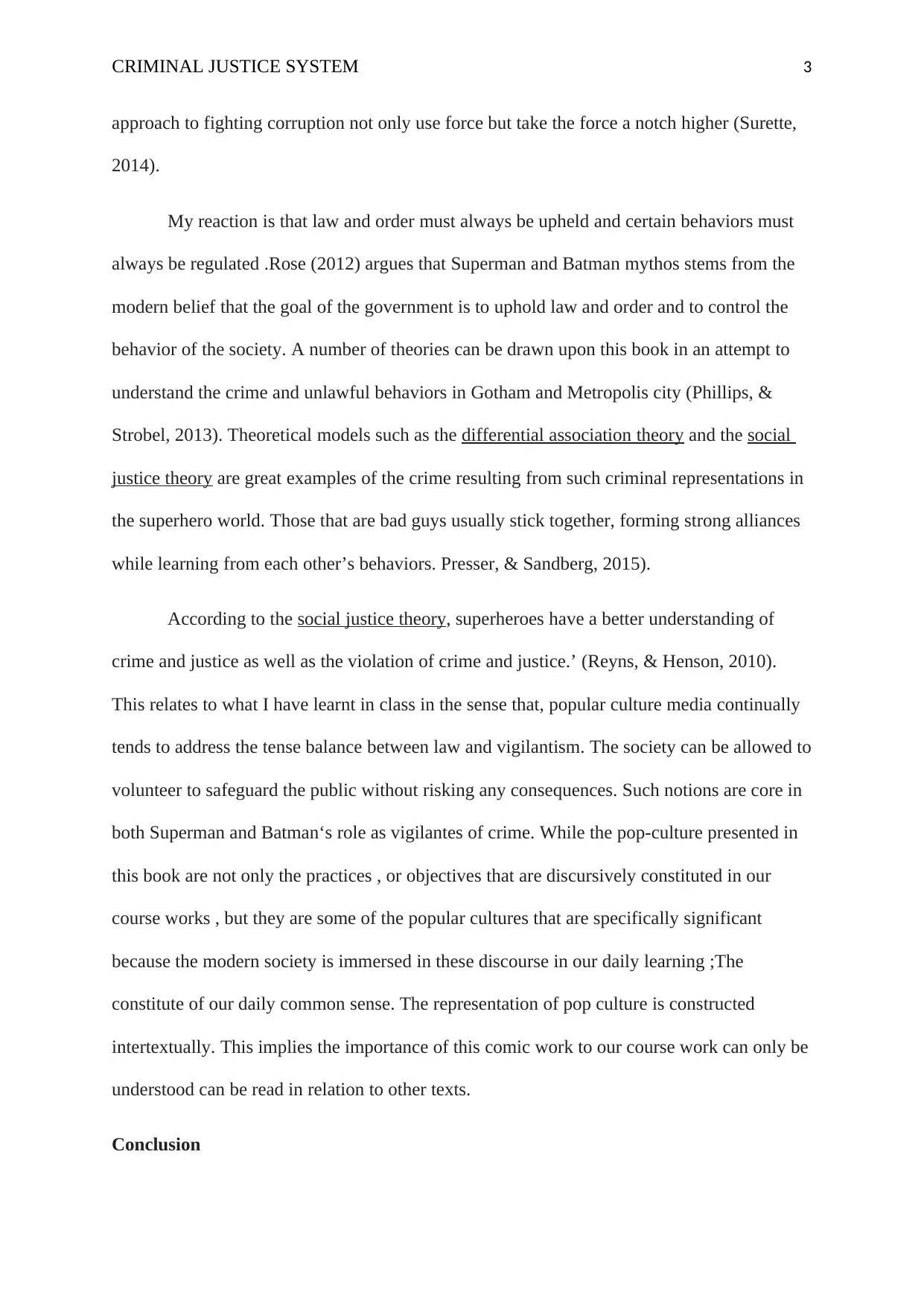
CRIMINAL JUSTICE SYSTEM 3
approach to fighting corruption not only use force but take the force a notch higher (Surette,
2014).
My reaction is that law and order must always be upheld and certain behaviors must
always be regulated .Rose (2012) argues that Superman and Batman mythos stems from the
modern belief that the goal of the government is to uphold law and order and to control the
behavior of the society. A number of theories can be drawn upon this book in an attempt to
understand the crime and unlawful behaviors in Gotham and Metropolis city (Phillips, &
Strobel, 2013). Theoretical models such as the differential association theory and the social
justice theory are great examples of the crime resulting from such criminal representations in
the superhero world. Those that are bad guys usually stick together, forming strong alliances
while learning from each other’s behaviors. Presser, & Sandberg, 2015).
According to the social justice theory, superheroes have a better understanding of
crime and justice as well as the violation of crime and justice.’ (Reyns, & Henson, 2010).
This relates to what I have learnt in class in the sense that, popular culture media continually
tends to address the tense balance between law and vigilantism. The society can be allowed to
volunteer to safeguard the public without risking any consequences. Such notions are core in
both Superman and Batman‘s role as vigilantes of crime. While the pop-culture presented in
this book are not only the practices , or objectives that are discursively constituted in our
course works , but they are some of the popular cultures that are specifically significant
because the modern society is immersed in these discourse in our daily learning ;The
constitute of our daily common sense. The representation of pop culture is constructed
intertextually. This implies the importance of this comic work to our course work can only be
understood can be read in relation to other texts.
Conclusion
approach to fighting corruption not only use force but take the force a notch higher (Surette,
2014).
My reaction is that law and order must always be upheld and certain behaviors must
always be regulated .Rose (2012) argues that Superman and Batman mythos stems from the
modern belief that the goal of the government is to uphold law and order and to control the
behavior of the society. A number of theories can be drawn upon this book in an attempt to
understand the crime and unlawful behaviors in Gotham and Metropolis city (Phillips, &
Strobel, 2013). Theoretical models such as the differential association theory and the social
justice theory are great examples of the crime resulting from such criminal representations in
the superhero world. Those that are bad guys usually stick together, forming strong alliances
while learning from each other’s behaviors. Presser, & Sandberg, 2015).
According to the social justice theory, superheroes have a better understanding of
crime and justice as well as the violation of crime and justice.’ (Reyns, & Henson, 2010).
This relates to what I have learnt in class in the sense that, popular culture media continually
tends to address the tense balance between law and vigilantism. The society can be allowed to
volunteer to safeguard the public without risking any consequences. Such notions are core in
both Superman and Batman‘s role as vigilantes of crime. While the pop-culture presented in
this book are not only the practices , or objectives that are discursively constituted in our
course works , but they are some of the popular cultures that are specifically significant
because the modern society is immersed in these discourse in our daily learning ;The
constitute of our daily common sense. The representation of pop culture is constructed
intertextually. This implies the importance of this comic work to our course work can only be
understood can be read in relation to other texts.
Conclusion
⊘ This is a preview!⊘
Do you want full access?
Subscribe today to unlock all pages.

Trusted by 1+ million students worldwide
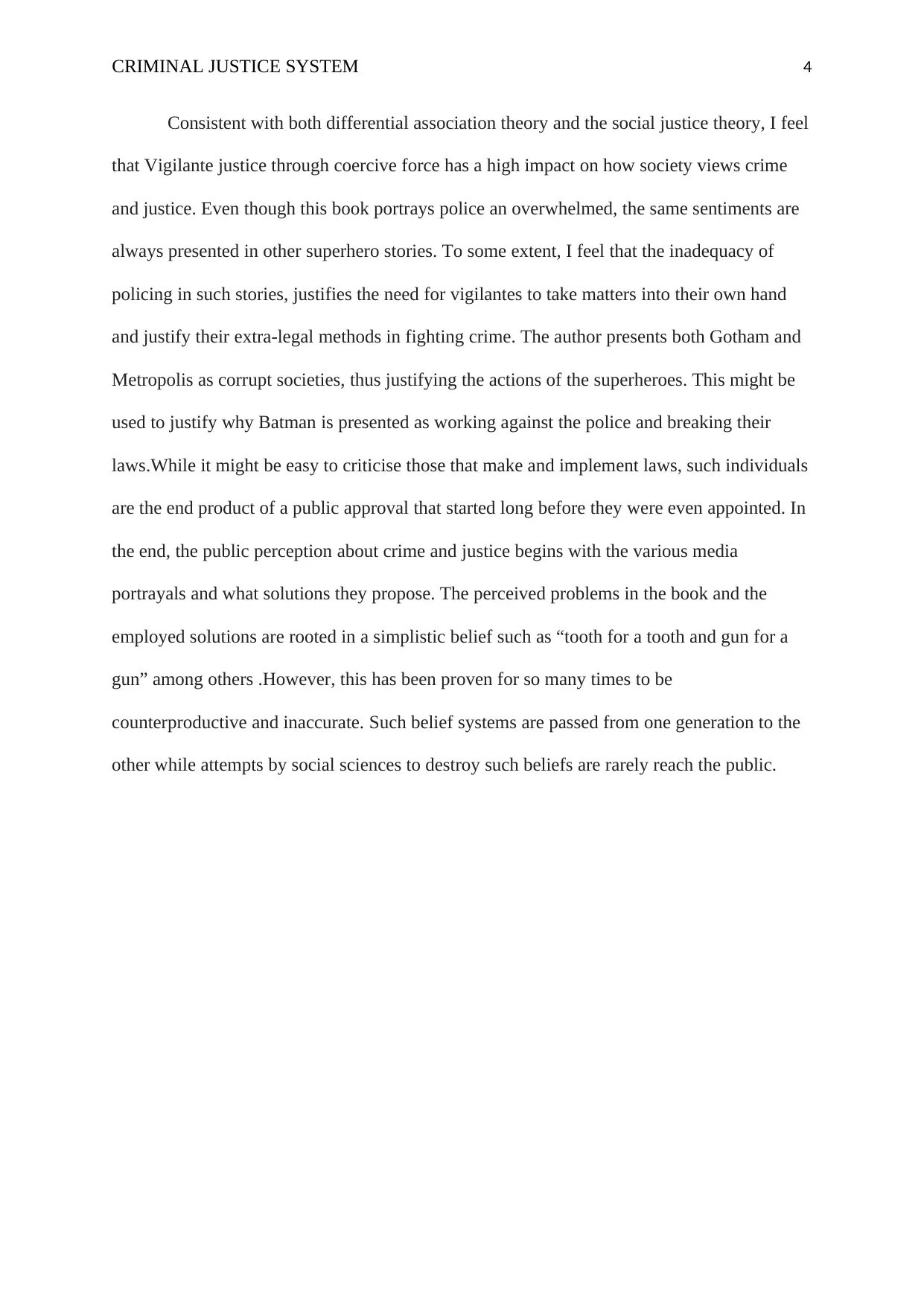
CRIMINAL JUSTICE SYSTEM 4
Consistent with both differential association theory and the social justice theory, I feel
that Vigilante justice through coercive force has a high impact on how society views crime
and justice. Even though this book portrays police an overwhelmed, the same sentiments are
always presented in other superhero stories. To some extent, I feel that the inadequacy of
policing in such stories, justifies the need for vigilantes to take matters into their own hand
and justify their extra-legal methods in fighting crime. The author presents both Gotham and
Metropolis as corrupt societies, thus justifying the actions of the superheroes. This might be
used to justify why Batman is presented as working against the police and breaking their
laws.While it might be easy to criticise those that make and implement laws, such individuals
are the end product of a public approval that started long before they were even appointed. In
the end, the public perception about crime and justice begins with the various media
portrayals and what solutions they propose. The perceived problems in the book and the
employed solutions are rooted in a simplistic belief such as “tooth for a tooth and gun for a
gun” among others .However, this has been proven for so many times to be
counterproductive and inaccurate. Such belief systems are passed from one generation to the
other while attempts by social sciences to destroy such beliefs are rarely reach the public.
Consistent with both differential association theory and the social justice theory, I feel
that Vigilante justice through coercive force has a high impact on how society views crime
and justice. Even though this book portrays police an overwhelmed, the same sentiments are
always presented in other superhero stories. To some extent, I feel that the inadequacy of
policing in such stories, justifies the need for vigilantes to take matters into their own hand
and justify their extra-legal methods in fighting crime. The author presents both Gotham and
Metropolis as corrupt societies, thus justifying the actions of the superheroes. This might be
used to justify why Batman is presented as working against the police and breaking their
laws.While it might be easy to criticise those that make and implement laws, such individuals
are the end product of a public approval that started long before they were even appointed. In
the end, the public perception about crime and justice begins with the various media
portrayals and what solutions they propose. The perceived problems in the book and the
employed solutions are rooted in a simplistic belief such as “tooth for a tooth and gun for a
gun” among others .However, this has been proven for so many times to be
counterproductive and inaccurate. Such belief systems are passed from one generation to the
other while attempts by social sciences to destroy such beliefs are rarely reach the public.
Paraphrase This Document
Need a fresh take? Get an instant paraphrase of this document with our AI Paraphraser
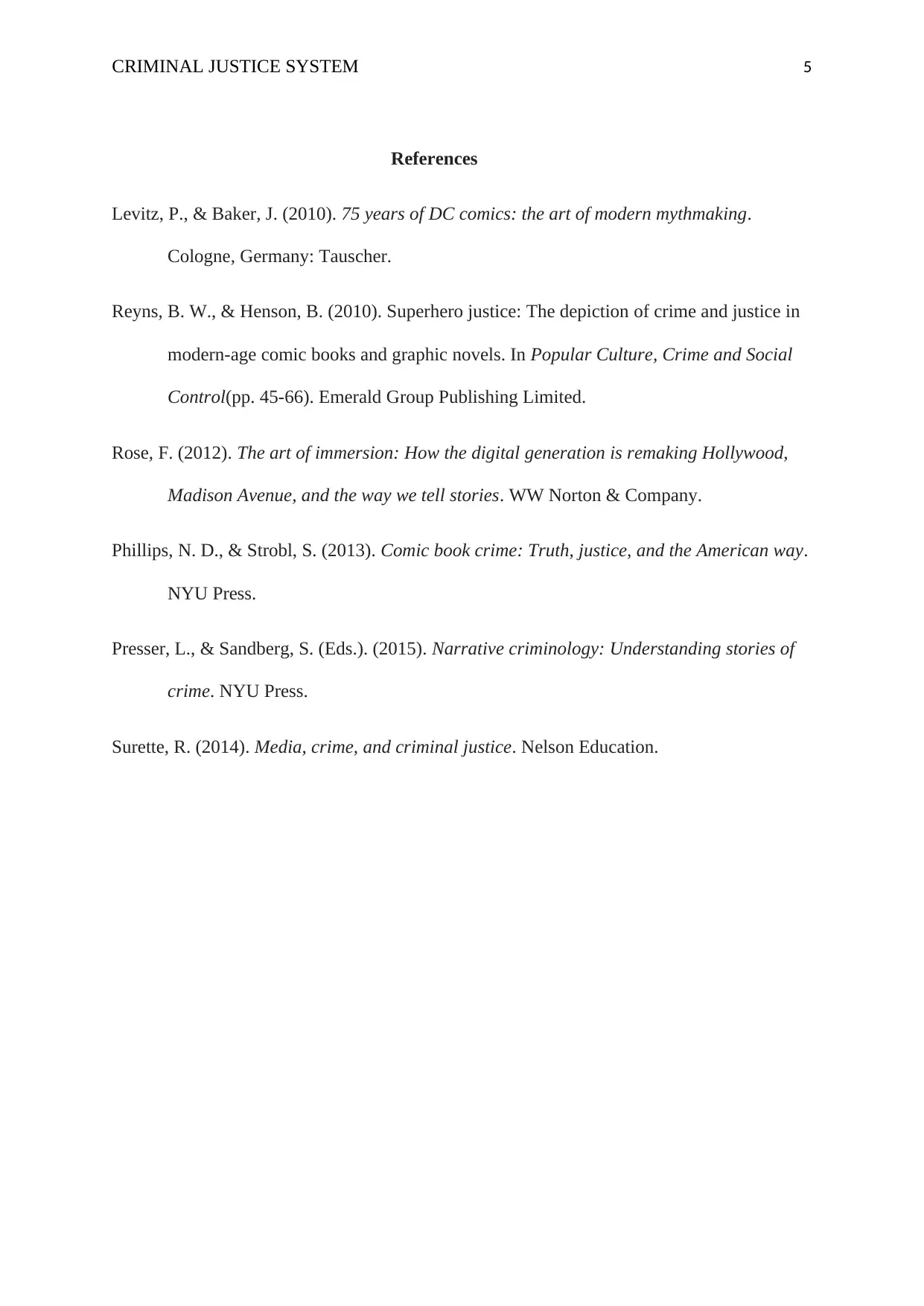
CRIMINAL JUSTICE SYSTEM 5
References
Levitz, P., & Baker, J. (2010). 75 years of DC comics: the art of modern mythmaking.
Cologne, Germany: Tauscher.
Reyns, B. W., & Henson, B. (2010). Superhero justice: The depiction of crime and justice in
modern-age comic books and graphic novels. In Popular Culture, Crime and Social
Control(pp. 45-66). Emerald Group Publishing Limited.
Rose, F. (2012). The art of immersion: How the digital generation is remaking Hollywood,
Madison Avenue, and the way we tell stories. WW Norton & Company.
Phillips, N. D., & Strobl, S. (2013). Comic book crime: Truth, justice, and the American way.
NYU Press.
Presser, L., & Sandberg, S. (Eds.). (2015). Narrative criminology: Understanding stories of
crime. NYU Press.
Surette, R. (2014). Media, crime, and criminal justice. Nelson Education.
References
Levitz, P., & Baker, J. (2010). 75 years of DC comics: the art of modern mythmaking.
Cologne, Germany: Tauscher.
Reyns, B. W., & Henson, B. (2010). Superhero justice: The depiction of crime and justice in
modern-age comic books and graphic novels. In Popular Culture, Crime and Social
Control(pp. 45-66). Emerald Group Publishing Limited.
Rose, F. (2012). The art of immersion: How the digital generation is remaking Hollywood,
Madison Avenue, and the way we tell stories. WW Norton & Company.
Phillips, N. D., & Strobl, S. (2013). Comic book crime: Truth, justice, and the American way.
NYU Press.
Presser, L., & Sandberg, S. (Eds.). (2015). Narrative criminology: Understanding stories of
crime. NYU Press.
Surette, R. (2014). Media, crime, and criminal justice. Nelson Education.
1 out of 5
Your All-in-One AI-Powered Toolkit for Academic Success.
+13062052269
info@desklib.com
Available 24*7 on WhatsApp / Email
![[object Object]](/_next/static/media/star-bottom.7253800d.svg)
Unlock your academic potential
Copyright © 2020–2025 A2Z Services. All Rights Reserved. Developed and managed by ZUCOL.